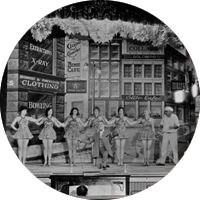
<< Go Back up to Theatre Research

The full text of “Writing for Vaudeville” by Brett Page (published by The Home Correspondence School in 1915) is available online here at the Internet Archive  or here on Google Books
or here on Google Books  .
.
To achieve success in any art the artist must know his tools and for what purposes they are designed. Furthermore, to achieve the highest success, he must know what he cannot do as well as what he can do with them.
The vaudeville stage – considered as a material thing – lends itself to only a few definite possibilities of use, and its scenery, lights and stage-effects constitute the box of tools the vaudeville write has at his command.
The footlights are the equator of the theatre, separating the “front of the house,” or auditorium, from the “back of the house,” or stage. The frame through which the audience views the stage is the “proscenium arch.” Flat against the stage side of the arch run the “house curtain” and the asbestos curtain that are raised at the beginning and lowered at the end of the performance.
That portion of the stage which lies between the curving footlights and a line drawn between the bases of the proscenium arch is called the “apron.” The apron is very wide in old-fashioned theatres, but is seldom more than two or three feet wide in recently built houses.
Back of the proscenium arch — four feet or more behind it — you have noticed canvas-covered wings painted in neutral-toned draperies to harmonize with every sort of curtain, and you have noticed that they are pushed forward or drawn back as it is found necessary to widen or make narrow the stage opening. These first wings, called “tormentors,” 1 extend upward from the floor — anywhere from 18 to 25 feet, — to the “Grand Drapery” and “Working Drapery,” or first “border,” which extend and hang just in front of them across the stage and hide the stage-rigging from the audience. The space lying between the tormentors and a line drawn between the bases of the proscenium arch is called “One.”
It is in One that monologues, most “single acts” — that is, acts presented by one person — and many “two-acts” — acts requiring but two people — are played.
Behind the tormentors is a curtain called the “olio,” which fulfills the triple purpose of hiding the rest of the stage, serving as scenery for acts in One and often as a curtain to raise and lower on acts playing in the space back of One.
Five, or six, or even seven feet behind the tormentors you have noticed another set of wings which — extending parallel with the tormentors — serve to mask the rest of stage. The space between these wings and the line of the olio is called “Two.”
In Two, acts such as flirtation-acts — a man and a woman playing lover-like scenes — which use scenery or small “props,” and all other turns requiring but a small playing space, are staged.
An equal number of feet back of the wings that bound Two, are wings that serve as boundaries for “Three.”
In Three, playlets that require but shallow sets, and other acts that need not more than twelve feet for presentation, are played.
Behind the wings that bound Three are another pair of wings, set an equal number of feet back, which serve as the boundaries of “Four.” But, as there are rarely more than four entrances on any stage, Four is usually called “Full Stage.”
In Full Stage are presented all acts such as acrobatic acts, animal turns, musical comedies, playlets and other pretentious acts that require deep sets and a wide playing space.
Sometimes the very point of a playlet depends upon showing not the conventional stage, as it is commonly seen, but the real stage as it is, unset with scenery; therefore sometimes the entire stage is used as the playing stage, and then in the vernacular it is called “Bare Stage.” 2
Below is a diagram of the stage of Keith’s Palace Theatre, New York City. A comparison of the preceding definitions with this diagram should give a clear understanding of the vaudeville playing stage.
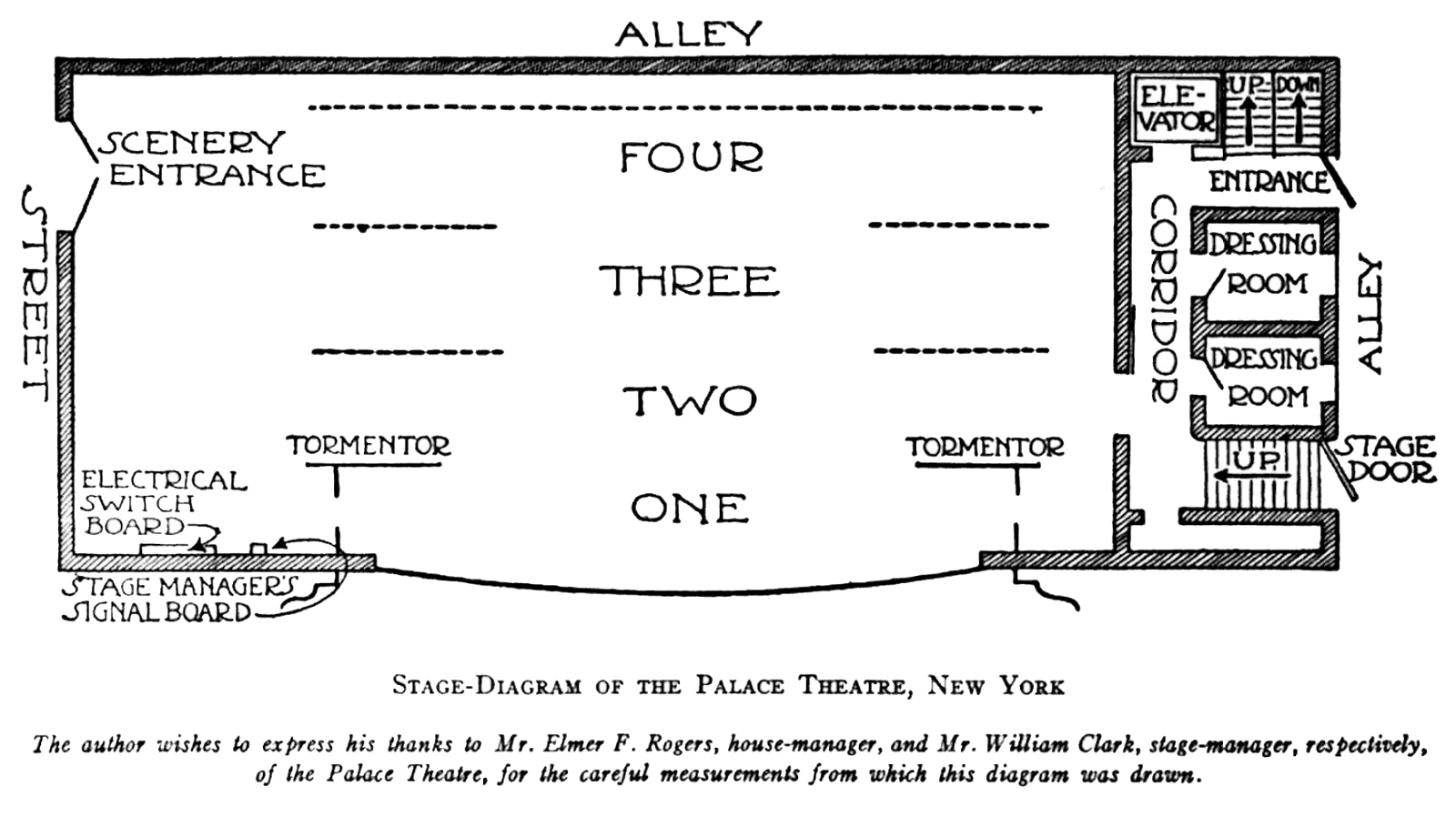
At audience-right — or stage-left — flat against the extended wall of the proscenium arch in the First Entrance (to One) there is usually a signal-board equipped with push buttons presided over by the stage-manager. The stage-manager is the autocrat behind the scenes. His duty is to see that the program is run smoothly without the slightest hitch or wait between acts and to raise and lower the olio, or to signal the act-curtain up or down, on cues. 3
When an act is ready to begin, the stage-manager pushes a button to signal the olio up or raises it himself — if that drop 4 is worked from the stage — and on the last cue he pushes another button to signal the curtain down, or lowers it himself, as the case may be. He keeps time on the various acts and sees that the performers are ready when their turn arrives. Under the stage-manager are the various departments to which the working of scenery and effects are entrusted.
As a rule the stage-manager is also the stage-carpenter. As such he, the wizard of scenery, has charge of the men, and is able to erect a palace, construct a tenement, raise a garden or a forest, or supply you with a city street in an instant.
Up on the wall of the stage, just under a network of iron called the “gridiron” — on which there are innumerable pulleys through which run ropes or “lines” that carry the scenery — there is, in the older houses, a balcony called the “fly-gallery.” Into the fly-gallery run the ends of all the lines that are attached to the counter-weighted drops and curtains; and in the gallery are the flymen who pull madly on these ropes to lift or lower the curtains and drops when the signal flashes under the finger of the stage-manager at the signal-board below. But in the newer houses nearly all drops and scenery are worked from the stage level, and the fly-gallery — if there is one — is deserted.
When a “set” is to be made, the stage-carpenter takes his place in the centre of the stage and claps his hands a certain number of times to make his men understand which particular set is wanted — if the sequence of the sets has not yet been determined and written down for the flymen to follow in definite order. Then the flymen lower a drop to its place on the stage and the “grips” push out the “flats” that make the wall of a room or the wings that form the scenery of a forest — or whatever the set may be.
Into the mimic room that the grips are setting comes the Property-man — “Props,” in stage argot — with his assistants, who place in the designated positions the furniture, bric-a-brac, pianos, and other properties, that the story enacted in this room demands.
After the act has been presented and the curtain has been rung down, the order to “strike” is given and the clearers run in and take away all the furniture and properties, while the property-man substitutes the new furniture and properties that are needed. This is done at the same time the grips and flymen are changing the scenery. No regiment is better trained in its duties. The property-man of the average vaudeville theatre is a hard- worked chap. Beside being an expert in properties, he must be something of an actor, for if there is an “extra man” needed in a playlet with a line or two to speak, it is on him that the duty falls. He must be ready on the instant with all sorts of effects, such as glass-crashes and wood-crashes, when a noise like a man being thrown downstairs or through a window is required, or if a doorbell or a telephone-bell must ring at a certain instant on a certain cue, or the noise of thunder, the wash of the sea on the shore, or any one of a hundred other effects be desired.
Upon the electrician fall all the duties of Jove in the delicate matter of making the sun to shine or the moon to cast its pale rays over a lover’s scene. Next to the stage-manager’s signal-board, or in a gallery right over it, or perhaps on the other side of the stage, stands the electric switch-board. From here all the stage lights and the lights in the auditorium and all over the front of the house are operated.
From the footlights with their red and white and blue and vari-tinted bulbs, to the borders that light the scenery from above, the bunch-lights that shed required lights through windows, the grate-logs, the lamps and chandeliers that light the mimic rooms themselves, and the spot-light operated by the man in the haven of the gallery gods out front, all are under the direction of the electrician who sits up in his little gallery and makes the moonlight suddenly give place to blazing sunlight on a cue.
It is to the stage-manager and the stage-carpenter, the property-man and the electrician, that are due the working of the stage miracles that delight us in the theatres.
In the ancient days before even candles were invented — the rush-light days of Shakespere [sic] and his predecessors — plays were presented in open courtyards or, as in France, in tennis-courts in the broad daylight. A proscenium arch was all the scenery usually thought necessary in these outdoor performances, and when the plays were given indoors even the most realistic scenery would have been of little value in the rush-lit semi-darkness. Then, indeed, the play was the thing. A character walked into the STORY and out of it again; and "place" was left to the imagination of the audience, aided by the changing of a sign that stated where the story had chosen to move itself.
As the centuries rolled along, improvements in lighting methods made indoor theatrical presentations more common and brought scenery into effective use. The invention of the kerosene lamp and later the invention of gas brought enough light upon the stage to permit the actor to step back from the footlights into a wider working-space set with the rooms and streets of real life. Then with the electric light came the scenic revolution that emancipated the stage forever from enforced gloomy darkness, permitted the actor’s expressive face to be seen farther back from the footlights, and made of the proscenium arch the frame of a picture.
“It is for this picture-frame stage that every dramatist is composing his plays,” Brander Matthews says; “and his methods are of necessity those of the picture-frame stage; just as the methods of the Elizabethan dramatic poet were of necessity those of the platform stage.” And on the same page: “The influence of the realistic movement of the middle of the nineteenth century imposed on the stage-manager the duty of making every scene characteristic of the period and of the people, and of relating the characters closely to their environment.” 5
On the vaudeville stage to-day, when all the sciences and the arts have come to the aid of the drama, there is no period nor place, nor even a feeling of atmosphere, that cannot be reproduced with amazing truth and beauty of effect. Everything in the way of scenery is artistically possible, from the squalid room of the tenement-dweller to the blossoming garden before the palace of a king — but artistic possibility and financial advisability are two very different things.
If an act is designed to win success by spectacular appeal, there is no doubt that it is good business for the producer to spend as much money as is necessary to make his effects more beautiful and more amazing than anything ever before seen upon the stage. But even here he must hold his expenses down to the minimum that will prove a good investment, and what he may spend is dependent on what the vaudeville managers will pay for the privilege of showing that act in their houses.
But it is not with spectacular acts that the vaudeville writer has particularly to deal. His problem is not compounded of extravagant scenery, gorgeous properties, trick-scenes and light-effects. Like Shakespere, for him the play — the story — is the thing. The problem he faces is an embarrassment of riches. With everything artistically possible, what is financially advisable?
The highest praise a vaudevillian can conjure up out of his vast reservoir of enthusiastic adjectives to apply to any act is, “It can be played in the alley and knock ’em cold.” In plain English he means, the STORY is so good that it doesn’t require scenery.
Scenery, in the business of vaudeville — please note the word “business” — has no artistic meaning. If the owner of a dwelling house could rent his property with the rooms unpapered and the woodwork un-painted, he would gladly do so and pocket the saving, wouldn’t he? In precisely the same spirit the vaudeville-act owner would sell his act without going to the expense of buying and transporting scenery, if he could get the same price for it. To the vaudevillian scenery is a business investment.
Because he can get more money for his act if it is properly mounted in a pleasing picture, the vaudeville producer invests in scenery. But he has to figure closely, just as every other business man is compelled to scheme and contrive in dollars and cents, or the business asset of scenery will turn into a white elephant and eat up all his profits.
Jesse L. Lasky, whose many pleasing musical acts will be remembered, had many a near-failure at the beginning of his vaudeville-producing career because of his artistic leaning toward the beautiful in stage setting. His subsequent successes were no less pleasing because he learned the magic of the scenery mystery. Lasky is but one example, and were it not that the names of vaudeville acts are but fleeting memories, dimmed and eclipsed by the crowded impressions of many acts seen at one sitting, there might be given an amazing list of beautiful little entertainments that have failed because of the transportation cost of the scenery they required.
When a producer is approached with a request to read a vaudeville act he invariably asks, “What scenery?” His problem is in two parts:
An experience of my own in producing a very small act — small enough to be in the primary class — may be as amusing as it is typical. My partners and I decided to put out a quartet. We engaged four good singers, two of them men, and two women. I wrote the little story that introduced them in a humorous way and we set to work rehearsing. At the same time the scenic artist hung three nice big canvases on his paint frames and laid out a charming street-scene in the Italian Quarter of Anywhere, the interior of a squalid tenement and the throne room of a palace.
The first drop was designed to be hung behind the Olio — for the act opened in One — and when the Olio went up, after the act’s name was hung out, the lights dimmed to the blue and soft green of evening in the Quarter. Then the soprano commenced singing, the tenor took up the duet, and they opened the act by walking rhythmically with the popular ballad air to stage-centre in the amber of the spot-light. When the duet was finished, on came the baritone, and then the contralto, and there was a little comedy before they sang their first quartet number.
Then the first drop was lifted in darkness and the scene changed to the interior of the squalid tenement in which the pathos of the little story unfolded, and a characteristic song was sung. At length the scene changed to the throne room of the palace, where the plot resolved itself into happiness and the little opera dosed with the “Quartet from Rigoletto.”
The act was a success; it never received less than five bows and always took two encores. But we paid three hundred and fifty dollars for those miracles of drops, my partners and I, and we used them only one week.
In the first place, the drops were too big for the stage on which we “tried out” the act. We could not use them there and played before the house street-drop and in the house palace set. The act went very well. We shipped the drops at length-rates — as all scenery is charged for by expressmen and railroads — to the next town. There we used them and the act went better. It was a question whether the bigger success was due to the smoother working of the act or to the beautiful drops.
The price for which the act was playing at that breaking-in period led me to ponder the cost of transporting the drops in their rolled-up form on the battens. Therefore when I was informed that the stage in the next town was a small one, I had a bright idea. I ordered the stage-carpenter to take the drops from their battens, discard the battens, and put pockets on the lower ends of the drops and equip the upper ends with tie ropes so the drops could be tied on the battens used in the various houses. The drops would then fit small or large stages equally well and could be folded up into a small enough space to tuck in a trunk and save all the excess transportation charges.
Of course the drops folded up all right, but they unfolded in chips of scaled-off paint. In the excitement, or the desire to “take a chance” I had not given a thought to the plain fact that the drops were not aniline. They were doomed to chip in time anyway, and folding only hastened their end. Still, we received just as much money for the act all the time we were playing it, as though we had carried the beautiful drops.
Now comes the third lesson of this incident: Although we were precisely three hundred and sixty-eight dollars “out” on account of the drops, we really saved money in the end because we were forced to discard them. The local union of the International Association of Theatrical Stage Employees — Stage Hands’ Union, for short — tried to assess me in the town where we first used the drops, for the salary of a stage-carpenter. According to their then iron-clad rule, before which managers had to bow, the scenery of every act carrying as many as three drops on battens had to be hung and taken down by the act’s own stage-carpenter — at forty dollars a week. They could not collect from such an act today because the rules have been changed, but our act was liable, under the old rules, and I evaded it only by diplomacy. But even to-day every act that carries a full set of scenery — such as a playlet requiring a special set — must carry its own stage-carpenter.
Therefore, to the problem of original cost and transportation expense, now add the charge of forty dollars a week against scenery — and an average of five dollars a week extra railroad fare for the stage-carpenter — and you begin to perceive why a vaudeville producer asks, when you request him to read an act: “What scenery?”
There is no intention of decrying the use of special scenery in vaudeville. Some of the very best and most profitable acts, even aside from great scenic one-act dramas like “The System,” would be comparatively valueless without their individual sets. And furthermore the use of scenery, with the far-reaching possibilities of the special set in all its beauty and — on this side of the water — hitherto unrealized effectiveness, has not yet even approached its noon. Together with the ceaseless advance of the art of mounting a full-evening play on the legitimate stage 6 will go the no less artistic vaudeville act. But, for the writer anxious to make a success of vaudeville writing, the special set should be decried. Indeed, the special set ought not to enter into the writer’s problem at all.
No scenery can make up for weakness of story. Rather, like a paste diamond in an exquisitely chased, pure gold setting, the paste story will appear at greater disadvantage^ because of the very beauty of its surroundings. The writer should make his story so fine that it will sparkle brilliantly in any setting.
The only thought that successful vaudeville writers give to scenery is to indicate in their manuscripts the surroundings that “relate the characters closely to their environment.”
It requires no ability to imagine startling and beautiful scenic effects that cost a lot of money to produce — that is no “trick.” The vaudeville scenery magic lies in making use of simple scenes that can be carried at little cost — or, better still for; the new writer, in twisting the combinations of drops and sets to be found in every vaudeville house to new uses.
In every vaudeville theatre there is an Olio and, although the scene which it is designed to represent may be different in each house, the street Olio is common enough to be counted as universally used. Usually there are two drops in “One,” either of which may be the Olio, and one of them is likely to represent a street, while the other is pretty sure to be a palace scene.
Usually in Four — and sometimes in Three — there are to be found in nearly every vaudeville theatre two different drops, which with their matching wings 7 form the two common “open sets” — or scenes composed merely of a rear drop and side wings, and not boxed in.
The Wood Set consists of a drop painted to represent the interior of a wood or forest, with wings painted in the same style. It is used for knock-about acts, clown acts, bicycle acts, animal turns and other acts that require a deep stage and can play in this sort of scene.
The Palace Set, with its drop and wings, is painted to represent the interior of a palace. It is used for dancing acts, acrobats and other acts that require a deep stage and can appropriately play in a palace scene.
A “box set” is, as the name implies, a set of scenery that is box-shaped. It represents a room seen through the fourth wall, which has been removed. Sometimes with a ceiling-piece, but almost invariably with “borders” — which are painted canvas strips hanging in front of the “border-lights” to mask them and keep the audience from seeing the ropes and pulleys hanging from the gridiron — the box set more nearly mimics reality than the open set, which calls upon the imagination of the audience to supply the realities that are entirely lacking or only hinted at.
The painted canvas units which are assembled to make the box set are called “flats.” A flat is a wooden frame about six feet six inches wide and from twelve to eighteen feet long, covered with canvas and, of course, painted with any scene desired. It differs from a wing in being only one-half the double frame; therefore it cannot stand alone.
Upon the upper end of each flat along the unpainted outer edge there is fastened a rope as long as the flat. Two-thirds of the way up from the bottom of the corresponding edge of the matching flat there is a “cleat,” or metal strip, into which the rope, or “lash-line” is snapped. The two flats are then drawn tight together so that their edges match evenly and the lash-line is lashed through the framework to hold the flats firmly together.
While one flat may be a painted wall, the next may contain a doorway and door, another a part of an ornamental arch, and still another a window, so, when the various flats are assembled and set, the box set will have the appearance of a room containing doors and windows and even ornamental arches. The most varied scenes can thus be realistically set up.
In the rear of open doors there are usually wings, or perhaps flats, 8 painted to represent the walls of hallways and adjoining rooms and they are called “interior backings.”
The Centre-door Fancy is the most common of the box sets. Called “fancy,” because it has an arch with portières and a rich-looking backing, and because it is supposed to lead into the other palatial rooms of the house, this set can be used for a less pretentious scene by the substitution of a matched door for the arch.
In this plainer form it is called simply The Parlor Set. Sometimes a parlor set is equipped with a French window, but this should not be commented on. But there are usually a grate and mantelpiece, and three doors. The doors are designed to be set, one in the rear wall, and one in each of the right and left walls. A ceiling-piece is rarely found, but borders are always to be had, and a chandelier is customary.
The Kitchen Set is, as the name implies, less pretentious than the changeable parlor set. It usually is equipped with three doors, possesses matching borders, may have an ordinary window, and often has a fireplace panel.
Slightly altered in appearance, by changing the positions of the doors and the not very common substitution of a “half -glass door” in the rear wall, the kitchen set does duty as The Office Set.
It is in these two box sets — changed in minor details to serve as four sets — that the vaudeville playlet is played.
On the following pages will be found eight diagrams showing how the stock or house box sets can be set in various forms. A study of these will show how two different acts using the same house set can be given surroundings that appear absolutely different. These diagrams should prove of great help to the playlet writer who wishes to know how many doors he may use, where they are placed and how his act will fit and play in a regulation set of scenery.
The following diagrams, showing the scenic equipment of the average vaudeville theatre, have been specially drawn for this volume and are used here by courtesy of the Lee Lash Studios, New York. As they are drawn to a scale of one-eighth of an inch to the foot, the precise size of the various scenes may be calculated.
The diagrams are based on the average vaudeville stage, which allows thirty or thirty-two feet between tormentors. The proscenium arch may be much greater, but the average vaudeville stage will set the tormentors about thirty feet apart. All vaudeville stage settings are made back of the tormentor line.
At the tormentor line there will be, of course, a Grand Drapery and Working Drapery which will mask the first entrance overhead.
There will be either a set of borders for each scene, or else the borders will be painted to use with any scene, to mask the stage rigging. The borders are usually hung from six to seven feet apart, so that in planning a scene this should be considered. In a few of the larger houses, a ceiling-piece is found, but, as has been said, this is so rare it should not be counted on.
Most houses have a floor cloth, and medallion or carpet, in addition to the properties hereafter described.
Reference to the diagrams will show that the tormentors have a "flipper," which runs to the proscenium arch wall; in the flipper is usually a door or a curtained opening for the entrances and exits of acts in One.
If you will combine with the diagrams shown these elements which cannot be diagrammed, you will have a clear idea of the way in which any scene is constructed. Then if you will imagine the scene you have in mind as being set up on a stage like that of the Palace Theatre, shown on page 31, you will have a working understanding of the vaudeville stage.
A well-ordered vaudeville stage, as has been described, possesses Drops for use in One, one or more Fancy Interiors, a Kitchen Set, and Exterior Sets. The Drops in One are omitted from these diagrams, because they would be represented merely by a line drawn behind the tormentors.
The Fancy Interiors may include a Light Fancy, a Dark Fancy, an Oak Interior, and a Plain Chamber set. As the differences are largely of painting, the usual Centre-door Fancy is taken as the basis for the variations — five different ways of setting it are shown.
Two out of the many different ways of setting the Kitchen Set are given.
The Exterior Set allows little or no variation; the only thing that can be done is to place balustrades, vases, etc., in different positions on the stage; therefore but one diagram is supplied.
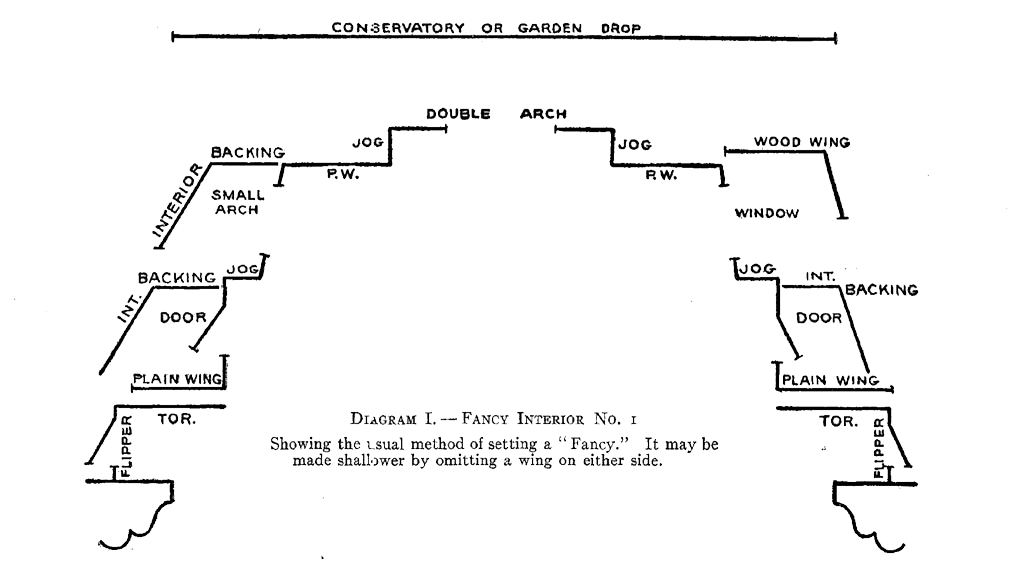
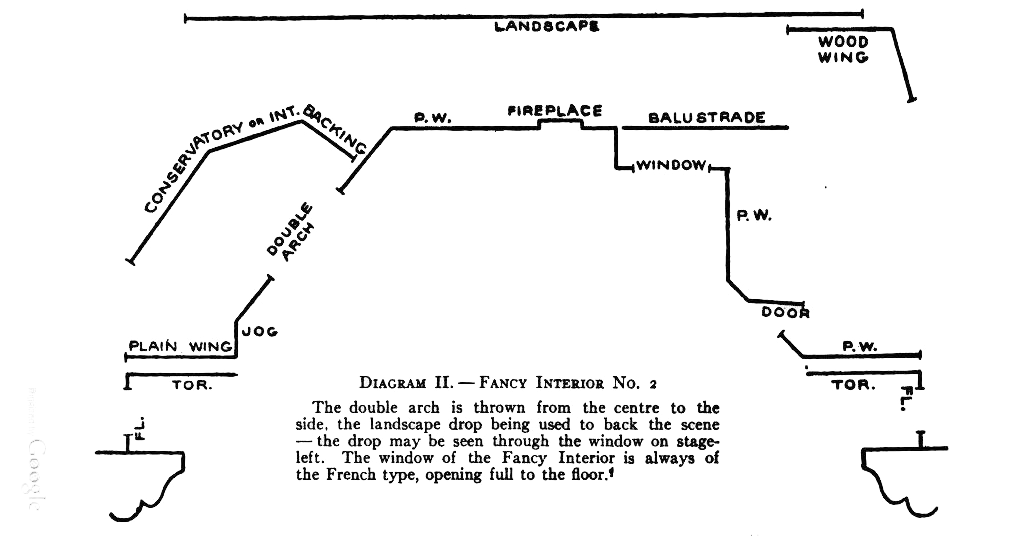
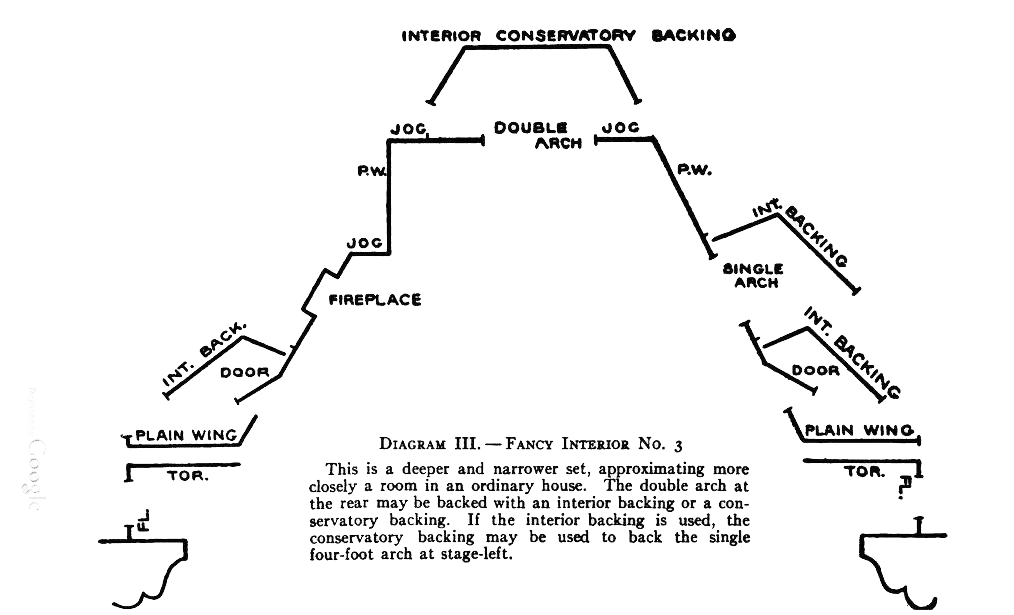
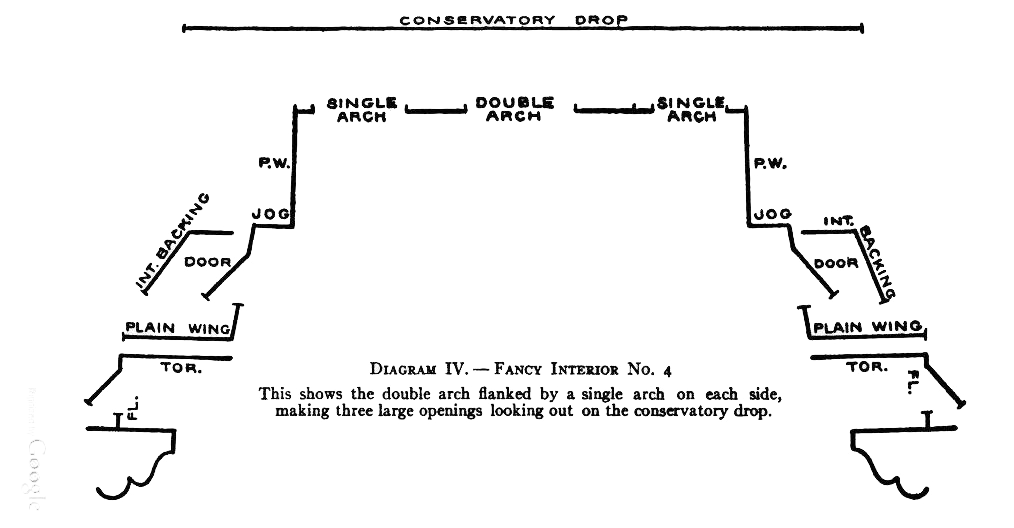

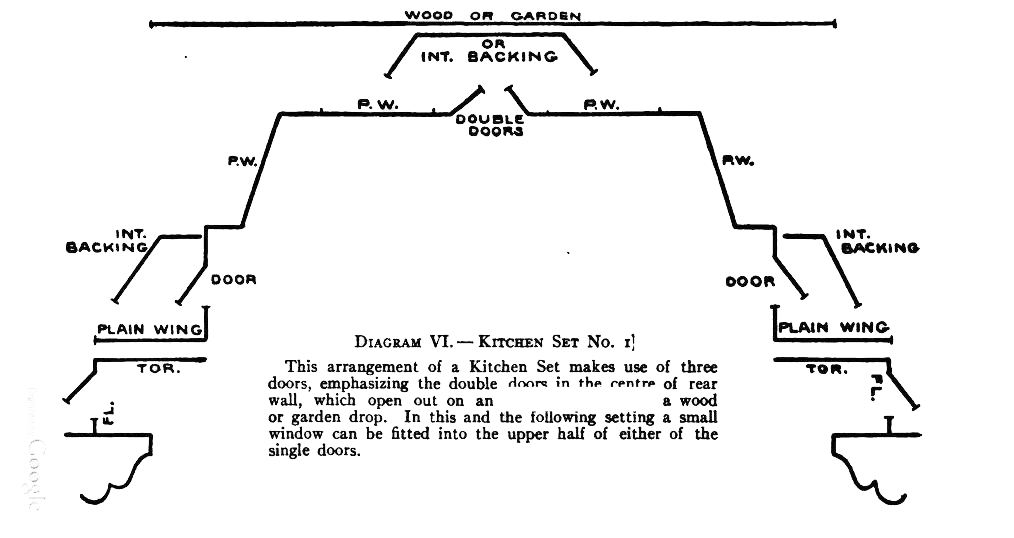
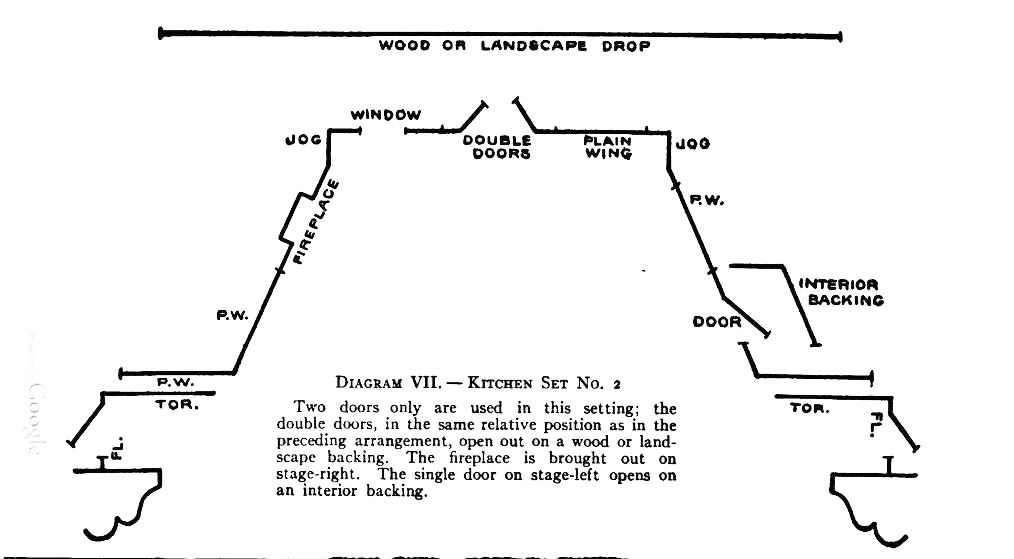
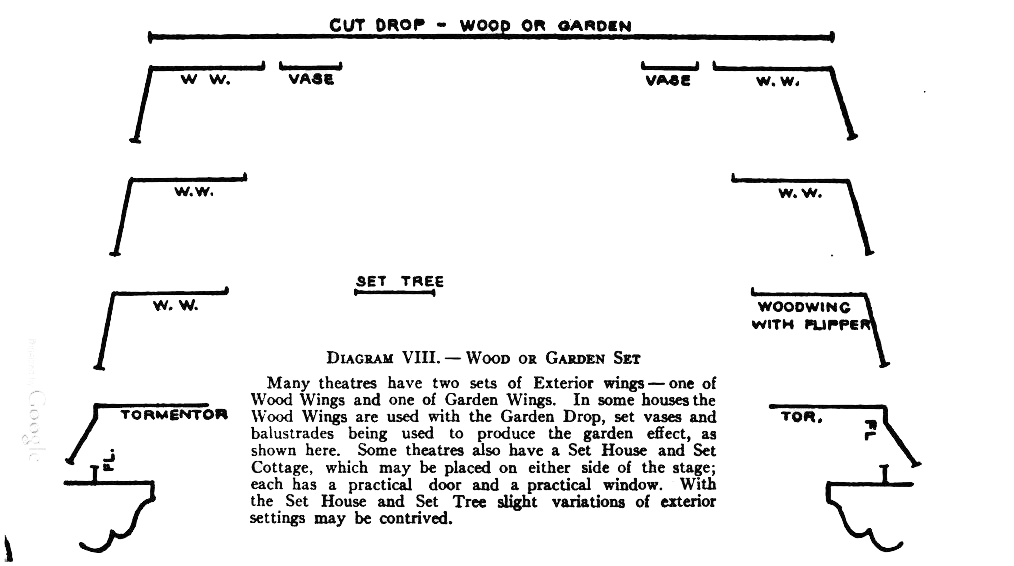
In the argot of the stage the word “property” or “prop” means any article — aside from scenery — necessary for the proper mounting or presentation of a play. A property may be a set of furniture, a rug, a pair of portières, a picture for the wall, a telephone, a kitchen range or a stew-pan — indeed, anything at all that is not scenery, although serving to complete the effect and illusion of a scene.
Furniture is usually only of two kinds in a vaudeville playhouse. There is a set of parlor furniture to go with the parlor set and a set of kitchen furniture to furnish the kitchen set. But, while these are all that are at the immediate command of the property-man, he is usually permitted to exchange tickets for the theatre with any dealer willing to lend needed sets of furniture, such as a desk or other office equipment specially required for the use of an act.
In this way the sets of furniture in the property room may be expanded with temporary additions into combinations of infinite variety. But, it is wise not to ask for anything out of the ordinary, for many theatre owners frown upon bills for hauling, even though the rent of the furniture may be only a pair of seats.
For the same reason, it is unwise to specify in the property-list — which is a printed list of the properties each act requires — anything in the way of rugs that is unusual. Though some theatres have more than two kinds of rugs, the white bear rug and the carpet rug are the most common.
It is also unwise to ask for pictures to hang on the walls. If a picture is required, one is usually supplied set upon an easel.
Of course, every theatre is equipped with prop telephones and sets of dishes and silver for dinner scenes. But there are few vaudeville houses in the country that have on hand a bed for the stage, although the sofa is commonly found.
A buffet, or sideboard, fully equipped with pitchers and wine glasses, is customary in every vaudeville property room. And champagne is supplied in advertising bottles which ^’pop" and sparkle none the less realistically because the content is merely ginger ale.
While the foregoing is not an exhaustive list of what the property room of a vaudeville theatre may contain, it gives the essential properties that are commonly found. Thus every ordinary requirement of the usual vaudeville act can be supplied.
The special properties that an act may require must be carried by the act. For instance, if a playlet is laid in an artist’s studio there are all sorts of odds and ends that would lend a realistic effect to the scene. A painter’s easel, bowls of paint brushes, a palette, half-finished pictures to hang on the walls, oriental draperies, a model’s throne, and half a dozen rugs to spread upon the floor, would lend an atmosphere of charming bohemian realism.
Special Sound-Effects fall under the same common-sense rule. For, while all vaudeville theatres have glass crashes, wood crashes, slap-sticks, thunder sheets, cocoanut shells for horses* hoof-beats, and revolvers to be fired off-stage, they could not be expected to supply such little-called-for effects as realistic battle sounds, volcanic eruptions, and like effects.
If an act depends on illusions for its appeal, it will, of course, be well supplied with the machinery to produce the required sounds. And those that do not depend on exactness of illusion can usually secure the effects required by calling on the drummer with his very effective box-of-tricks to help out the property-man.
At the electrical switchboard centre all the lights of the theatre, as well as those of the stage itself. Presided over by the electrician, the switchboard, so far as the stage and its light effects are concerned, commands two classes of lights. The first of these is the arc light and the second the electric bulb.
The Spot-lights are the lamps that depend upon the arc for their illumination. If you have ever sat in the gallery of any theatre, and particularly of a vaudeville theatre, you certainly have noticed the very busy young man whose sole purpose in life appears to be to follow the heroine around the stage with the focused spot of light that shines like a halo about her. The lamp with which he accomplishes this difficult feat is appropriately called a “spot-light.” While there are often spot-lights on the electrician’s “bridge,” as his balcony is called, the gallery out front is the surest place to find the spot-light.
The Footlights are electric bulbs dyed amber, blue, and red — or any other special shade desired — beside the well-known white, set in a tin trough sunk in the stage and masked to shine only upon the stage. By causing only one group of colors to light, the electrician can secure all sorts of variations, and with the aid of “dimmers” permit the lights to shine brilliantly or merely to glow with faint radiance.
The Border-lights are electric bulbs of varying colors set in tin troughs a little longer than the proscenium opening and are suspended above the stage behind the scenery borders. They shine only downward. There are border-lights just in front of the drops in One, Two, Three and Four, and they take the names of “first border-light,” “second border-light,” and so on from the drops they illuminate.
Strip-lights are electric bulbs set in short strips of tin troughs, that are equipped with hooks by which they can be hung behind doors and out-of-the-way dark places in sets to illuminate the backings.
A Bunch-light is a box of tin set on a standard, which can be moved about the stage the length of its electric cord, and has ten or twelve electric bulbs inside that cast a brilliant illumination wherever it is especially desired. Squares of gelatine in metal frames can be slipped into the grooves in front of the bunch-light to make the light any color or shade desired. These boxes are especially valuable in giving the effect of blazing sunlight just outside the doors or windows of a set, or to shine through the windows in the soft hue of moonlight.
Grate Logs are found in nearly every vaudeville house and are merely iron painted to represent logs of wood, inside of which are concealed lamps that shine up through red gelatine, simulating the glow of a wood fire shining in the fireplace under the mantelpiece usually found in the centre-door-fancy set.
Special Light-effects have advanced so remarkably with the science of stage illumination that practically any effect of nature may be secured. If the producer wishes to show the water rippling on the river drop there is a “ripple-lamp” at his command, which is a clock-actuated mechanism that slowly revolves a ripple glass in front of a “spot-lamp” and casts a realistic effect of water rippling in the moonlight.
By these mechanical means, as well as others, the moon or the sun can be made to shine through a drop and give the effect of rising or of setting, volcanos can be made to pour forth blazing lava and a hundred other amazing effects can be obtained. In fact, the modern vaudeville stage is honeycombed with trapdoors and overhung with arching light-bridges, through which and from which all manner of lights can be thrown upon the stage, either to illuminate the faces of the actors with striking effect, or to cast strange and beautiful effects upon the scenery. Indeed, there is nothing to be seen in nature that the electrician cannot reproduce upon the stage with marvellous fidelity and pleasing effect.
But the purpose here, as in explaining all the other physical departments of the vaudeville stage, is not to tell what has been done and what can be done, interesting and instructive as such a discussion would be, but to describe what is usually to be found in a vaudeville theatre. The effects that are at ready command are the only effects that should interest anyone about to write for vaudeville. As was emphasized in the discussion of scenery, the writer should not depend for success on the unusual. His aim should be to make use of the common stage- effects that are found on every vaudeville stage — if, indeed, he depends on any effects at all.
Here, then, we have made the acquaintance of the physical proportions and aspects of the vaudeville stage and have inquired into all the departments that contribute to the successful presentation of a vaudeville entertainment. We have examined the vaudeville writer’s tool-box and have learned to know the uses for which each tool of space, scenery, property, and light is specially designed. And by learning what these tools can do, we have also learned what they cannot do.
1. No one of the score I have asked for the origin of the word tormentor has been able to give it. They all say they have asked old-time stage-carpenters, but even they did not know. (return)
2. The New Leader, written by Aaron Hoffman and played for so many years by Sam Mann & Company, is an excellent example of a Bare Stage act. (return)
3. A cue is a certain word or action regarded as the signal for some other speech or action by another actor, or the signal for the lights to change or a bell to ring or something to happen during the course of a dramatic entertainment. (return)
4. A drop is the general name for a curtain of canvas — painted to represent some scene and stretched on a batten — a long, thick strip of wood — pocketed in the lower end to give the canvas the required stability. Sets of lines are tied to the upper batten on which the drop is tied and thus the drop can be raised or lowered to its place on the stage. There are sets of lines in the rear boundaries of One, Two, Three and Four, and drops can be hung on any desired set. (return)
5. The Study of the Drama, Brander Matthews. (return)
6. The Theatre of To-Day, Hiram Kelly Moderwell’s book on the modem theatre, will repay reading by anyone particularly interested in the special set and its possibilities. (return)
7. A wing is a double frame of wood covered with painted canvas and set to stand as this book will when its covers are opened at right angles to each other. (return)
Photographs copyright © 2002-2025 Mike Hume / Historic Theatre Photos unless otherwise noted.
Text copyright © 2017-2025 Mike Hume / Historic Theatre Photos.
For photograph licensing and/or re-use contact me here  .
.
| Follow Mike Hume’s Historic Theatre Photography: |  |
 |